Question 1
Consider the curve `C` defined by `y^2=sin(xy),y≠0`.
(a) Show that `dy/( dx)=(ycos(xy))/(2y-xcos(xy))`
(b) Prove that, when `dy/( dx)=0,y=±1`
(c) Hence find the coordinates of all points on `C`, for `0 < x < 4π`, where `dy/( dx)=0`.
Mark as Complete
Mark Scheme
Question 2
A camera at point C is 3 m from the edge of a straight section of road as shown in the following diagram. The camera detects a car travelling along the road at t = 0. It then rotates, always pointing at the car, until the car passes O, the point on the edge of the road closest to the camera.
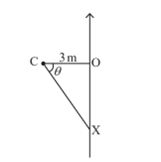
A car travels along the road at a speed of 24 ms⁻¹. Let the position of the car be X and let OCX = θ.
Find `(dθ)/dt`, the rate of rotation of the camera, in radians per second, at the instant the car passes the point O.
Mark as Complete
Mark Scheme
Question 3
Find the coordinates of the points on the curve `y^3+3xy^2-x^3=27` at which `dy/( dx)=0`
Mark as Complete
Mark Scheme
Question 4
If `2x^2-3y^2=2`, find the two values of `dy/( dx)` when `x=5`.
Mark as Complete
Mark Scheme
Question 5
A shop uses the following model to estimate `n`, the number of smoothies sold per day, in terms of `x`, the price of a single smoothie in pesos.
`n=40000/x^2`
The maximum number of smoothies the shop can make in a day is 400 .
(a) Find the maximum price they could charge per smoothie for the shop to sell 400 in one day.
(b) On a day when the shop sells smoothies at 50 pesos each, use the model to find
(i) the number of smoothies sold.
(ii) the total income from the smoothies sold.
The cost of making each smoothie is 20 pesos. The profit per day `P` is the total income from the sale of smoothies that day minus the cost of making them.
(c)
(i) Show that, according to the model, `P=40000/x-800000/x^2`
(ii) Find `(dP)/( dx)`
(iii) Find the value of `x` for which `(dP)/( dx)=0`.
(iv) Find the number of smoothies sold when the profit is maximized
Mark as Complete
Mark Scheme
Question 6
A plane takes off from a horizontal runway. Let point O be the point where the plane begins to leave the runway and x be the horizontal distance, in km, of the plane from O. The function h models the vertical height, in km, of the nose of the plane from the horizontal runway, and is defined by
`h(x)=10/(1+150e^(-0.07x) )-0.06, x≥0`
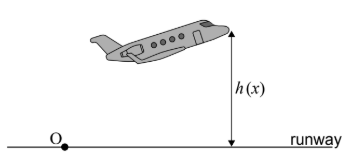 (a) (i) Find `h(0)`
(a) (i) Find `h(0)`
(ii) Interpret this value in terms of the context.
(b) (i) Find the horizontal asymptote of the graph of `y=h(x)`
(ii) Interpret this value in terms of the context.
(c) Find `h'(x)` in terms of x.
A safety regulation recommends that h'(x) never exceed 0.2.
(d) Given that this plane flies a distance of at least 200 km horizontally from point O, determine whether the plane is following this safety regulation.
Mark as Complete
Mark Scheme
Question 7
A particular park consists of a rectangular garden, of area A m², and a concrete path surrounding it. The park has a total area of 1200 m².
The width of the path at the north and south side of the park is 2 m.
The width of the path at the west and east side of the park is 1.5 m.
The length of the park (along the north and south sides) is x metres, 3 < x < 300.
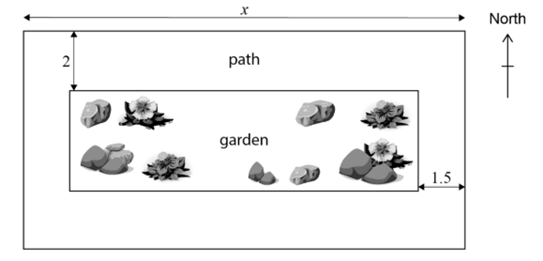
(a) Show that `A = 1212 – 4x – 3600/x.`
(b) Find the possible dimensions of the park if the area of the garden is 800 m²
(c) Find an expression for `(dA)/dx`.
(d) Use your answer from part (c) to find the value of x that will maximize the area of the garden.
(e) Find the maximum possible area of the garden.
Mark as Complete
Mark Scheme
Question 8
An environmental scientist is asked by a river authority to model the effect of a leak from a power plant on the mercury levels in a local river. The variable `x` measures the concentration of mercury in micrograms per litre.
The situation is modelled using the second order differential equation
`(d^2 x)/( dt^2 )+3 ( dx)/( dt)+2x=0`
where `t>=0` is the time measured in days since the leak started. It is known that when `t=0,x=0` and `(dx)/(dt)=1`.
(a) Show that the system of coupled first order equations:
`(dx)/( dt)=y`
`( dy)/( dt)=-2x-3y`
can be written as the given second order differential equation.
(b) Find the eigenvalues of the system of coupled first order equations given in part (a).
(c) Hence find the exact solution of the second order differential equation.
(d) Sketch the graph of `x` against `t`, labelling the maximum point of the graph with its coordinates.
If the mercury levels are greater than 0.1 micrograms per litre, fishing in the river is considered unsafe and is stopped.
(e) Use the model to calculate the total amount of time when fishing should be stopped.
The river authority decides to stop people from fishing in the river for 10% longer than the time found from the model.
(f) Write down one reason, with reference to the context, to support this decision.
Mark as Complete
Mark Scheme
Question 9
A cafe makes `x` litres of coffee each morning. The cafe's profit each morning, `C`, measured in dollars, is modelled by the following equation
`C=x/10 (k^2-3/100 x^2 )`
where `k` is a positive constant.
(a) Find an expression for `(dC)/dx` in terms of `k` and `x`.
(b) Hence find the maximum value of `C` in terms of `k`. Give your answer in the form `pk^3`, where `p` is a constant.
The cafe's manager knows that the cafe makes a profit of $426 when 20 litres of coffee are made in a morning.
(c)
(i) Find the value of k.
(ii) Use the model to find how much coffee the café should make each morning to maximize its profit.
(d) Sketch the graph of C against x , labelling the maximum point and the x-intercepts with their coordinates.
The manager of the cafe wishes to serve as many customers as possible.
(e) Determine the maximum amount of coffee the cafe can make that will not result in a loss of money for the morning.
Mark as Complete
Mark Scheme
Question 10
A sector of a circle, centre O and radius 4.5 m, is shown in the following diagram.

(a) (i) Find the angle AOB.
(ii) Find the area of the shaded segment.
A square field with side 8 m has a goat tied to a post in the centre by a rope such that the goat can reach all parts of the field up to 4.5 m from the post.
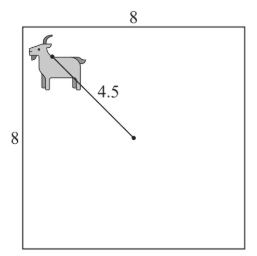
(b) Find the area of the field that can be reached by the goat.
Let `V` be the volume of grass eaten by the goat, in cubic metres, and `t` be the length of time, in hours, that the goat has been in the field.
The goat eats grass at the rate of `(dV)/( dt)=0.3te^(-t)`
(c) Find the value of `t` at which the goat is eating grass at the greatest rate.
The goat is tied in the field for 8 hours.
(d) Find the total volume of grass eaten by the goat during this time.
Mark as Complete
Mark Scheme
Question 1
Consider the curve `C` defined by `y^2=sin(xy),y≠0`.
(a) Show that `dy/( dx)=(ycos(xy))/(2y-xcos(xy))`
(b) Prove that, when `dy/( dx)=0,y=±1`
(c) Hence find the coordinates of all points on `C`, for `0 < x < 4π`, where `dy/( dx)=0`.
(a) attempt at implicit differentiation
`2y ( dy)/( dx)=cos(xy)[x ( dy)/( dx)+y]`
`2y ( dy)/( dx)=x ( dy)/( dx) cos(xy)+ycos(xy)`
`2y ( dy)/( dx)-x ( dy)/( dx) cos(xy)=ycos(xy)`
`dy/( dx)(2y-xcos(xy))=ycos(xy)`
`dy/( dx)=(ycos(xy))/(2y-xcos(xy))`
(b) setting `dy/( dx)=0`
`ycos(xy)=0`
`(y≠0)⇒cos(xy)=0`
`⇒sin(xy)=±sqrt(1-cos^2 (xy) )=±sqrt(1-0)=±1`
`xy=(2n+1)π/2(n∈Z)`
`xy=π/2,(3π)/2,…`
`y^2 =sin(xy)>0`
`⇒y^2=1`
`⇒y=±1`
(c) `y=±1⇒1=sin(±x)⇒sinx=±1`
OR `y=±1⇒0=cos(±x)⇒cosx=0`
`sinx=1⇒(π/2,1),((5π)/2,1)`
`sinx=-1⇒((3π)/2,-1),((7π)/2,-1)`
Question 2
A camera at point C is 3 m from the edge of a straight section of road as shown in the following diagram. The camera detects a car travelling along the road at t = 0. It then rotates, always pointing at the car, until the car passes O, the point on the edge of the road closest to the camera.

A car travels along the road at a speed of 24 ms⁻¹. Let the position of the car be X and let OCX = θ.
Find `(dθ)/dt`, the rate of rotation of the camera, in radians per second, at the instant the car passes the point O.
let `OX=x`
`dx/( dt)=24` (or -24 )
`(dθ)/dt=(dx)/( dt)×(dθ)/dx`
`3tanθ=x`
`3sec^2 θ=dx/( dθ)`
`(dθ)/dt=24/(3sec^2 θ)`
attempt to substitute for `θ=0` into their differential equation
`(dθ)/dt=24/3=8` (rad `s^(-1)`)
Question 3
Find the coordinates of the points on the curve `y^3+3xy^2-x^3=27` at which `dy/( dx)=0`
attempt at implicit differentiation
`3y^2 ( dy)/( dx)+3y^2+6xy ( dy)/( dx)-3x^2=0`
substitution of `dy/( dx)=0`
`3y^2-3x^2=0`
`⇒y=±x`
substitute either variable into original equation
`y=x⇒x^3=9⇒x=root(3)9 " (or " y^3=9⇒y=root(3)9 " )"`
`y=-x⇒x^3=27⇒x=3" (or " y^3=-27⇒y=-3)`
`(root(3)9,root(3)9),(3,-3)`
Question 4
If `2x^2-3y^2=2`, find the two values of `dy/( dx)` when `x=5`.
By implicit differentiation,
`d/( dx) (2x^2-3y^2=2)⇒4x-6y ( dy)/( dx)=0`
`⇔( dy)/( dx)=(4x)/(6y)`
When `x=5,50-3y^2=2`
`⇔ y^2=16`
`⇔ y=±4`
Therefore `dy/( dx)=±5/6`
Question 5
A shop uses the following model to estimate `n`, the number of smoothies sold per day, in terms of `x`, the price of a single smoothie in pesos.
`n=40000/x^2`
The maximum number of smoothies the shop can make in a day is 400 .
(a) Find the maximum price they could charge per smoothie for the shop to sell 400 in one day.
(b) On a day when the shop sells smoothies at 50 pesos each, use the model to find
(i) the number of smoothies sold.
(ii) the total income from the smoothies sold.
The cost of making each smoothie is 20 pesos. The profit per day `P` is the total income from the sale of smoothies that day minus the cost of making them.
(c)
(i) Show that, according to the model, `P=40000/x-800000/x^2`
(ii) Find `(dP)/( dx)`
(iii) Find the value of `x` for which `(dP)/( dx)=0`.
(iv) Find the number of smoothies sold when the profit is maximized
(a) `40000/x^2 =400`
`x=10` (pesos) (since `x` is positive)
(b)
(i) `40000/50^2 =16`
(ii) `50×16=800` (pesos)
(c) (i) profit for each smoothie `=x-20`
`P=40000/x^2 ×(x-20)`
`P=40000/x-800000/x^2`
(ii) attempt to express `P` ready for power rule
`P=40000x^(-1)-800000x^(-2)`
`( dP)/( dx)=-40000/x^2 +1600000/x^3`
(iii) attempt to find `x`-value
e.g. sketch of `(dP)/dx` with `x`-intercept indicated
`x=40`
(iv) attempt to substitute their `x`-value into equation for `n`
`n=40000/40^2`
`=25`
Question 6
A plane takes off from a horizontal runway. Let point O be the point where the plane begins to leave the runway and x be the horizontal distance, in km, of the plane from O. The function h models the vertical height, in km, of the nose of the plane from the horizontal runway, and is defined by
`h(x)=10/(1+150e^(-0.07x) )-0.06, x≥0`
 (a) (i) Find `h(0)`
(a) (i) Find `h(0)`
(ii) Interpret this value in terms of the context.
(b) (i) Find the horizontal asymptote of the graph of `y=h(x)`
(ii) Interpret this value in terms of the context.
(c) Find `h'(x)` in terms of x.
A safety regulation recommends that h'(x) never exceed 0.2.
(d) Given that this plane flies a distance of at least 200 km horizontally from point O, determine whether the plane is following this safety regulation.
(a)
(i) `h(0)=0.00623(km)(=0.00622517)`
(ii)
this is the height of the nose of the plane (above the runway), when the plane is on the runway
(b)
(i) `y=9.94`
(iii)
this is the height that the (nose of the) plane approaches (but does not reach)
(c)
`h(x)=10(1+150e^(-0.07x) )^(-1)-0.06`
find `h^' (x)=-10(1+150e^(-0.07x) )^(-2)×150e^(-0.07x)×-0.07`
`(=(105e^(-0.07x))/(1+150e^(-0.07x) )^2 )`
(d)
evidence of a graph of `h'(x)`
maximum at `x=71.6 (=71.58051…)`
`h^' (71.58051…)=0.175`
maximum gradient is less than 0.2
and hence the regulation is being followed
Question 7
A particular park consists of a rectangular garden, of area A m², and a concrete path surrounding it. The park has a total area of 1200 m².
The width of the path at the north and south side of the park is 2 m.
The width of the path at the west and east side of the park is 1.5 m.
The length of the park (along the north and south sides) is x metres, 3 < x < 300.

(a) Show that `A = 1212 – 4x – 3600/x.`
(b) Find the possible dimensions of the park if the area of the garden is 800 m²
(c) Find an expression for `(dA)/dx`.
(d) Use your answer from part (c) to find the value of x that will maximize the area of the garden.
(e) Find the maximum possible area of the garden.
(a)
(width of park =) `1200/x`
(length of garden =) `x-3`, (width of garden =) `1200/x-4`
(b)
setting `1212-4x-3600/x=800` (accept a sketch)
`x=9.64(9.64011…)(m)` OR `x=93.4(93.3598…)(m)`
(width =) `124(124.479…)(m)`
(width =) `12.9(12.8534…)(m)`
(c)
`((dA)/( dx)=)-4+3600/x^2`
(d)
setting their `(dA)/dx` equal to 0 OR sketch of their `(dA)/dx` with `x`-intercept highlighted
`(x=)30 (m)`
(e)
evidence of using GDC to find maximum of graph of `A=1212-4x-3600/x`
`(A=)972(m^2 )`
Question 8
An environmental scientist is asked by a river authority to model the effect of a leak from a power plant on the mercury levels in a local river. The variable `x` measures the concentration of mercury in micrograms per litre.
The situation is modelled using the second order differential equation
`(d^2 x)/( dt^2 )+3 ( dx)/( dt)+2x=0`
where `t>=0` is the time measured in days since the leak started. It is known that when `t=0,x=0` and `(dx)/(dt)=1`.
(a) Show that the system of coupled first order equations:
`(dx)/( dt)=y`
`( dy)/( dt)=-2x-3y`
can be written as the given second order differential equation.
(b) Find the eigenvalues of the system of coupled first order equations given in part (a).
(c) Hence find the exact solution of the second order differential equation.
(d) Sketch the graph of `x` against `t`, labelling the maximum point of the graph with its coordinates.
If the mercury levels are greater than 0.1 micrograms per litre, fishing in the river is considered unsafe and is stopped.
(e) Use the model to calculate the total amount of time when fishing should be stopped.
The river authority decides to stop people from fishing in the river for 10% longer than the time found from the model.
(f) Write down one reason, with reference to the context, to support this decision.
(a) differentiating first equation.
`(d^2 x)/( dt^2 )=dy/( dt)`
substituting in for `(dy)/dt`
`=-2x-3y=-2x-3 ( dx)/( dt)`
therefore `(d^2 x)/( dt^2 )+3 ( dx)/( dt)+2x=0`
(b) the relevant matrix is `((0,1),(-2,-3))`
(this has characteristic equation) `-λ(-3-λ)+2=0`
`λ=-1,-2`
(c) the general solution is `x=Ae^(-t)+Be^(-2t)`
so `dx/( dt)=-Ae^(-t)-2Be^(-2t)`
the initial conditions become:
`0=A+B`
`1=-A-2B`
this is solved by `A=1, B=-1`
so the solution is `x=e^(-t)-e^(-2t)`
(d)
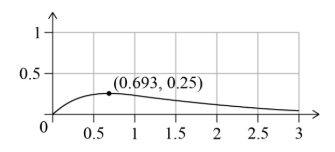
(e) intersecting graph with y = 0.1
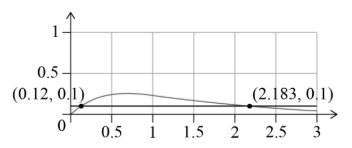
so the time fishing is stopped between 2.1830... and 0.11957... = 2.06(343...) days
(f) Any reasonable answer. For example:
There are greater downsides to allowing fishing when the levels may be dangerous than preventing fishing when the levels are safe.
The concentration of mercury may not be uniform across the river due to natural variation / randomness.
The situation at the power plant might get worse.
Mercury levels are low in water but still may be high in fish.
Question 9
A cafe makes `x` litres of coffee each morning. The cafe's profit each morning, `C`, measured in dollars, is modelled by the following equation
`C=x/10 (k^2-3/100 x^2 )`
where `k` is a positive constant.
(a) Find an expression for `(dC)/dx` in terms of `k` and `x`.
(b) Hence find the maximum value of `C` in terms of `k`. Give your answer in the form `pk^3`, where `p` is a constant.
The cafe's manager knows that the cafe makes a profit of $426 when 20 litres of coffee are made in a morning.
(c)
(i) Find the value of k.
(ii) Use the model to find how much coffee the café should make each morning to maximize its profit.
(d) Sketch the graph of C against x , labelling the maximum point and the x-intercepts with their coordinates.
The manager of the cafe wishes to serve as many customers as possible.
(e) Determine the maximum amount of coffee the cafe can make that will not result in a loss of money for the morning.
(a) attempt to expand given expression OR attempt at product rule
`C=(xk^2)/10-(3x^3)/1000`
`( dC)/( dx)=k^2/10-(9x^2)/1000`
(b) equating their `(dC)/dx` to zero
`k^2/10-(9x^2)/1000=0`
`x^2=(100k^2)/9`
`x=(10k)/3`
substituting their `x` back into given expression
`C_max=(10k)/30 (k^2-(300k^2)/900)`
`C_max=(2k^3)/9 (0.222…k^3 )`
(c)
(i) substituting 20 into given expression and equating to 426
`426=20/10 (k^2-3/100(20)^2 )`
`k=15`
(ii) 50
(d)

(e) Setting their expression for C to zero OR choosing correct x-intercept on their graph of C
xmax = 86.6 (86.6025…) litres
Question 10
A sector of a circle, centre O and radius 4.5 m, is shown in the following diagram.

(a) (i) Find the angle AOB.
(ii) Find the area of the shaded segment.
A square field with side 8 m has a goat tied to a post in the centre by a rope such that the goat can reach all parts of the field up to 4.5 m from the post.

(b) Find the area of the field that can be reached by the goat.
Let `V` be the volume of grass eaten by the goat, in cubic metres, and `t` be the length of time, in hours, that the goat has been in the field.
The goat eats grass at the rate of `(dV)/( dt)=0.3te^(-t)`
(c) Find the value of `t` at which the goat is eating grass at the greatest rate.
The goat is tied in the field for 8 hours.
(d) Find the total volume of grass eaten by the goat during this time.
(a)
(i) `(1/2 hat(AOB)=)arccos(4/4.5)=27.266…`
`hat(AOB)=54.532…≈54.5^∘ (0.951764…≈0.952" radians ")`
(ii) finding area of triangle
area of triangle `=1/2×4.5^2×sin(54.532…)=8.24621…≈8.25m^2`
finding area of sector
area of sector `=(54.532…)/360×π×4.5^2=9.63661…≈9.64m^2`
area of segment `=9.63661…-8.24621… =1.39m^2 (1.39040…)`
(b)

`π×4.5^2 (63.6172…)`
`4×1.39040…(5.56160)`
subtraction of four segments from area of circle `=58.1m^2 (58.055…)`
(c) `(dV)/( dt)=0.110363…` OR attempt to find where `(d^2 V)/( dt^2 )=0`
`t=1` hour
(d) recognizing `V=∫(dV)/( dt) dt`
`∫_0^(8)0.3 te^(-t) dt`
volume eaten is `0.299…m^3 (0.299094…)`
Question 1
Consider the curve `C` defined by `y^2=sin(xy),y≠0`.
(a) Show that `dy/( dx)=(ycos(xy))/(2y-xcos(xy))`
(b) Prove that, when `dy/( dx)=0,y=±1`
(c) Hence find the coordinates of all points on `C`, for `0 < x < 4π`, where `dy/( dx)=0`.
Question 2
A camera at point C is 3 m from the edge of a straight section of road as shown in the following diagram. The camera detects a car travelling along the road at t = 0. It then rotates, always pointing at the car, until the car passes O, the point on the edge of the road closest to the camera.

A car travels along the road at a speed of 24 ms⁻¹. Let the position of the car be X and let OCX = θ.
Find `(dθ)/dt`, the rate of rotation of the camera, in radians per second, at the instant the car passes the point O.
Question 3
Find the coordinates of the points on the curve `y^3+3xy^2-x^3=27` at which `dy/( dx)=0`
Question 4
If `2x^2-3y^2=2`, find the two values of `dy/( dx)` when `x=5`.
Question 5
A shop uses the following model to estimate `n`, the number of smoothies sold per day, in terms of `x`, the price of a single smoothie in pesos.
`n=40000/x^2`
The maximum number of smoothies the shop can make in a day is 400 .
(a) Find the maximum price they could charge per smoothie for the shop to sell 400 in one day.
(b) On a day when the shop sells smoothies at 50 pesos each, use the model to find
(i) the number of smoothies sold.
(ii) the total income from the smoothies sold.
The cost of making each smoothie is 20 pesos. The profit per day `P` is the total income from the sale of smoothies that day minus the cost of making them.
(c)
(i) Show that, according to the model, `P=40000/x-800000/x^2`
(ii) Find `(dP)/( dx)`
(iii) Find the value of `x` for which `(dP)/( dx)=0`.
(iv) Find the number of smoothies sold when the profit is maximized
Question 6
A plane takes off from a horizontal runway. Let point O be the point where the plane begins to leave the runway and x be the horizontal distance, in km, of the plane from O. The function h models the vertical height, in km, of the nose of the plane from the horizontal runway, and is defined by
`h(x)=10/(1+150e^(-0.07x) )-0.06, x≥0`
 (a) (i) Find `h(0)`
(a) (i) Find `h(0)`
(ii) Interpret this value in terms of the context.
(b) (i) Find the horizontal asymptote of the graph of `y=h(x)`
(ii) Interpret this value in terms of the context.
(c) Find `h'(x)` in terms of x.
A safety regulation recommends that h'(x) never exceed 0.2.
(d) Given that this plane flies a distance of at least 200 km horizontally from point O, determine whether the plane is following this safety regulation.
Question 7
A particular park consists of a rectangular garden, of area A m², and a concrete path surrounding it. The park has a total area of 1200 m².
The width of the path at the north and south side of the park is 2 m.
The width of the path at the west and east side of the park is 1.5 m.
The length of the park (along the north and south sides) is x metres, 3 < x < 300.

(a) Show that `A = 1212 – 4x – 3600/x.`
(b) Find the possible dimensions of the park if the area of the garden is 800 m²
(c) Find an expression for `(dA)/dx`.
(d) Use your answer from part (c) to find the value of x that will maximize the area of the garden.
(e) Find the maximum possible area of the garden.
Question 8
An environmental scientist is asked by a river authority to model the effect of a leak from a power plant on the mercury levels in a local river. The variable `x` measures the concentration of mercury in micrograms per litre.
The situation is modelled using the second order differential equation
`(d^2 x)/( dt^2 )+3 ( dx)/( dt)+2x=0`
where `t>=0` is the time measured in days since the leak started. It is known that when `t=0,x=0` and `(dx)/(dt)=1`.
(a) Show that the system of coupled first order equations:
`(dx)/( dt)=y`
`( dy)/( dt)=-2x-3y`
can be written as the given second order differential equation.
(b) Find the eigenvalues of the system of coupled first order equations given in part (a).
(c) Hence find the exact solution of the second order differential equation.
(d) Sketch the graph of `x` against `t`, labelling the maximum point of the graph with its coordinates.
If the mercury levels are greater than 0.1 micrograms per litre, fishing in the river is considered unsafe and is stopped.
(e) Use the model to calculate the total amount of time when fishing should be stopped.
The river authority decides to stop people from fishing in the river for 10% longer than the time found from the model.
(f) Write down one reason, with reference to the context, to support this decision.
Question 9
A cafe makes `x` litres of coffee each morning. The cafe's profit each morning, `C`, measured in dollars, is modelled by the following equation
`C=x/10 (k^2-3/100 x^2 )`
where `k` is a positive constant.
(a) Find an expression for `(dC)/dx` in terms of `k` and `x`.
(b) Hence find the maximum value of `C` in terms of `k`. Give your answer in the form `pk^3`, where `p` is a constant.
The cafe's manager knows that the cafe makes a profit of $426 when 20 litres of coffee are made in a morning.
(c)
(i) Find the value of k.
(ii) Use the model to find how much coffee the café should make each morning to maximize its profit.
(d) Sketch the graph of C against x , labelling the maximum point and the x-intercepts with their coordinates.
The manager of the cafe wishes to serve as many customers as possible.
(e) Determine the maximum amount of coffee the cafe can make that will not result in a loss of money for the morning.
Question 10
A sector of a circle, centre O and radius 4.5 m, is shown in the following diagram.

(a) (i) Find the angle AOB.
(ii) Find the area of the shaded segment.
A square field with side 8 m has a goat tied to a post in the centre by a rope such that the goat can reach all parts of the field up to 4.5 m from the post.

(b) Find the area of the field that can be reached by the goat.
Let `V` be the volume of grass eaten by the goat, in cubic metres, and `t` be the length of time, in hours, that the goat has been in the field.
The goat eats grass at the rate of `(dV)/( dt)=0.3te^(-t)`
(c) Find the value of `t` at which the goat is eating grass at the greatest rate.
The goat is tied in the field for 8 hours.
(d) Find the total volume of grass eaten by the goat during this time.